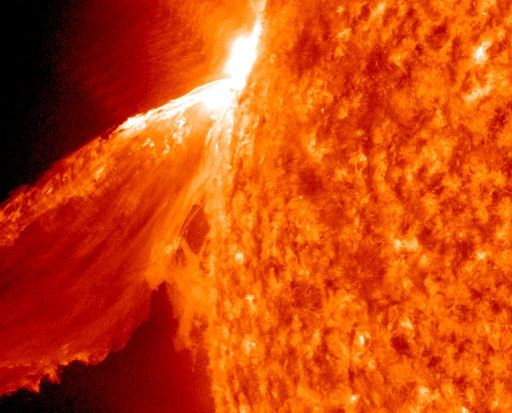Turn your cell phone into a field-tested satellite tracker. Works for Android and iPhone. | | |
LIFTOFF! The final voyage of space shuttle Discovery is underway. The orbiter lifted off at 4:53 p.m. EST Thursday from NASA’s Kennedy Space Center in Florida on a 12-day mission to deliver Robonaut 2 and supplies to the International Space Station. Check NASA's launch blog for updates.
EASTERN BLAST: The quiet didn't last long. Earth-orbiting satellites detected an M3-class solar flare at 0735 UT on Feb. 24th. The source was an active region located just behind the sun's eastern limb. The eruption produced strong radio emissions, a coronal mass ejection (not Earth directed), and this spectacular picture taken by NASA's Solar Dynamics Observatory:

Movies of the event are now available. Pick your favorite format: 6 MB Quicktime, 1 MB iPad, 0.5 MB iPhone (more formats will be available soon). The instigating active region will emerge over the eastern limb during the next 24-48 hours, setting the stage for possible geoeffective solar activity. Stay tuned for updates.
SOLAR SAIL FLARE: Last night (Feb. 23), NanoSail-D sailed over Seinäjoki, Finland, and when it did, the spacecraft's reflective fabric caught a sunbeam and flared. "I've never seen anything like it," says Juha Peräsaari who recorded the event using a Canon 400D digital camera:

Photo details: Canon EOS 400D, 20mm lens, f2.8, ISO100, 10s exposure. [more]
"NanoSail-D 'flashed' just as it passed the star Procyon," he says. "For a moment, the sail was the brighter of the two." This means NanoSail-D can flare at least to magnitude +0.3 (the brightness of Procyon), or almost twice as bright as a first magnitude star.
Even brighter flares could be in the offing. The orbit of NanoSail-D is decaying as it skims the top of Earth's atmosphere. Sunglints from the descending sail could intensify to Venus-brightness and beyond. Anyone who photographs such an event could win $500.
NanoSail-D Photo Gallery
[NASA: Solar Sail Stunner] [Photo Contest]
February 2011 Aurora Photo Gallery
[previous Februaries: 2010, 2009, 2008, 2007, 2006, 2004, 2003, 2002]
Potentially Hazardous Asteroids (
PHAs) are space rocks larger than approximately 100m that can come closer to Earth than 0.05 AU. None of the known PHAs is on a collision course with our planet, although astronomers are finding
new ones all the time.
On February 24, 2011 there were 1198 potentially hazardous asteroids.
Notes: LD means "Lunar Distance." 1 LD = 384,401 km, the distance between Earth and the Moon. 1 LD also equals 0.00256 AU. MAG is the visual magnitude of the asteroid on the date of closest approach. | | The official U.S. government space weather bureau |
| | The first place to look for information about sundogs, pillars, rainbows and related phenomena. |
| | Researchers call it a "Hubble for the sun." SDO is the most advanced solar observatory ever. |
| | 3D views of the sun from NASA's Solar and Terrestrial Relations Observatory |
| | Realtime and archival images of the Sun from SOHO. |
| | from the NOAA Space Environment Center |
| | the underlying science of space weather |
| | for out-of-this-world printing and graphics |

